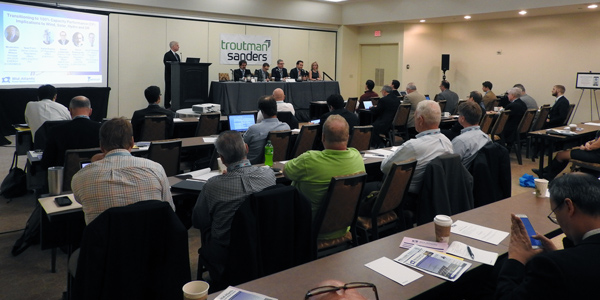By Rory D. Sweeney
PHILADELPHIA, Pa. — “We don’t know the right answer,” PJM Senior Market Strategist Andrew Levitt said last week. “We think the right answer is going to emerge.”
Levitt was speaking on a panel about distributed energy resource integration in PJM, but the comment could have applied to any of the topics discussed at last week’s Mid-Atlantic Power Market Summit hosted by Infocast.
With all the technological innovation and game changing occurring in the power industry, market rules are having to move quickly to keep pace. While some PJM stakeholders are reluctant to jump to decisions, others have urged that decisions — right or not — have to be made.
“Recently, the market has been thrown upside down,” said Scott Taylor, vice president at generation developer Moxie Energy. “I think the political risk is a big issue that even if it gets sorted out, there’s an overhang with what’s the next attempt?”
Taylor, whose company focuses on gas-fired generation, was referring to the Department of Energy’s recent proposal to provide price supports for coal and nuclear resources. He said that the Notice of Proposed Rulemaking and state subsidies for nuclear units known as zero-emissions credits (ZECs) have shut down investment. Three states — Illinois, New York and Connecticut — have instituted ZEC programs.
Michael Ferguson, director of U.S energy infrastructure for Standard & Poor’s, said the financial woes for such large-scale units hasn’t been a surprise.
“You can almost see it in slow motion where you know there’s a problem out there,” he said. “It’s been playing out in slow motion for a long time.”
Scalpels and Sledgehammers
Surprising or not, the issue has created enough market fervor that the conference featured a debate between Joe Bowring, PJM’s Independent Market Monitor, and Kathleen Barron, Exelon’s senior vice president of competitive market policy. Exelon’s nuclear facilities are the beneficiary of the ZEC programs in both Illinois and New York.
The debate focused on the minimum offer price rule (MOPR), which screens capacity auctions for subsidized bids and exchanges them for class-specific standardized offers. In current market conditions, the restated bids effectively ensure that such bids don’t receive capacity obligations and inappropriately suppress the clearing price.
Responding to criticism of the rule, Bowring said he has “yet to hear one iota of evidence” of it hurting market participants. “It’s very much not a sledgehammer; it’s very much a scalpel,” he said.
Barron questioned the timing of concerns. “We didn’t have a minimum offer price rule for renewables. … Why do we suddenly care about it when it’s nuclear?”
She noted that the ZEC payments can adjust downward to reflect changing market conditions, but Bowring countered that they never adjust negatively to pay consumers back.
“Clearly, there’s an efficient way to deal with carbon,” he said. “This is an inefficient way to handle it.”
Barron said the programs allowed states to prevent backsliding on emissions levels until they can develop long-term policies.
“Versus the replacement cost of bringing on new generation that’s clean, [the ZEC payment] is a bargain,” she said. “It’s cheaper to keep them than to let them go. … You need to have an objective way to value what you care about, and once you do that, you let the chips fall where they may.”
Plants that still can’t cover their costs after receiving carbon valuations should then retire, she said.
Beyond the ZECs, Bowring criticized the NOPR, which he said would cost up to $32 billion per year, as “a stalking horse for something else.” (See related story, Cost Estimates of DOE NOPR: $300 million to $32 billion+.)
“I don’t think it was intended as a serious proposal,” he said.
While it might be cheaper to keep existing plants than build new ones, he said it “eliminates alternative investment.”
“We also need to determine whether the current gas pipeline business model is the right one if we’re going to rely on it further,” he said.
Downside of Cheap Gas

Taylor said his company is not interested in developing renewable resources because the field has “too many players in it right now” and remains “real estate heavy.”
Andrew Rosenbaum, a managing director at RBC Capital Markets, agreed that renewables can’t support themselves.
“No one’s really building merchant renewables,” he said. “How many of the various support mechanisms do you get your arms around is an interesting question.”
Jim Guidera, who heads Credit Agricole CIB’s energy and infrastructure group, noted that potential for corporate taxes reductions under President Trump has made it harder to make deals because there could be less benefit for writing off failed projects.
“Elections matter,” he said. And with gas remaining at low prices, “it’s a tough model.”
That low gas is stifling innovation, according to Abe Silverman, deputy general counsel at NRG Energy.
“When prices are high, we incent creativity and we incent innovation. With the shale gas revolution, the price to beat is too low right now,” he said. “I think we need to raise the price to drive decarbonization.”
Silverman debated with Scott Vogt, vice president of energy acquisition at Commonwealth Edison, over who should control engagement with end-use customers. With incumbent utilities solely allowed to consolidate charges into a single bill, “we’re basically competing for one line on the bill,” Silverman said.
Vogt countered that retail suppliers are able to send separate bills if they prefer and in fact asked utilities to bill for them.









